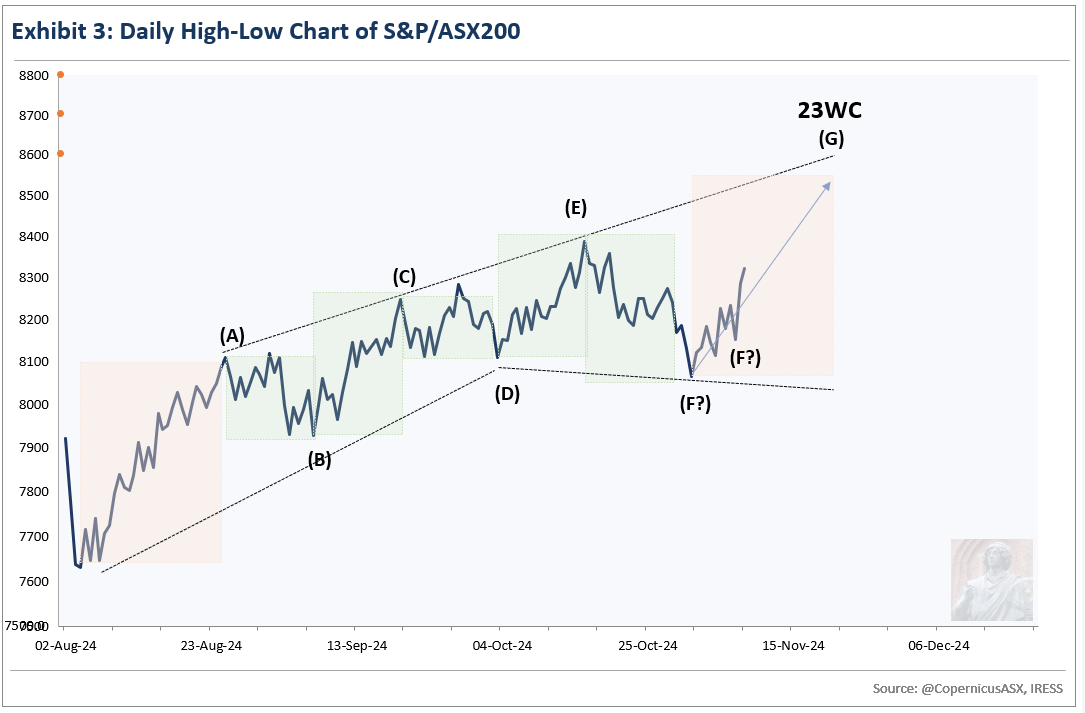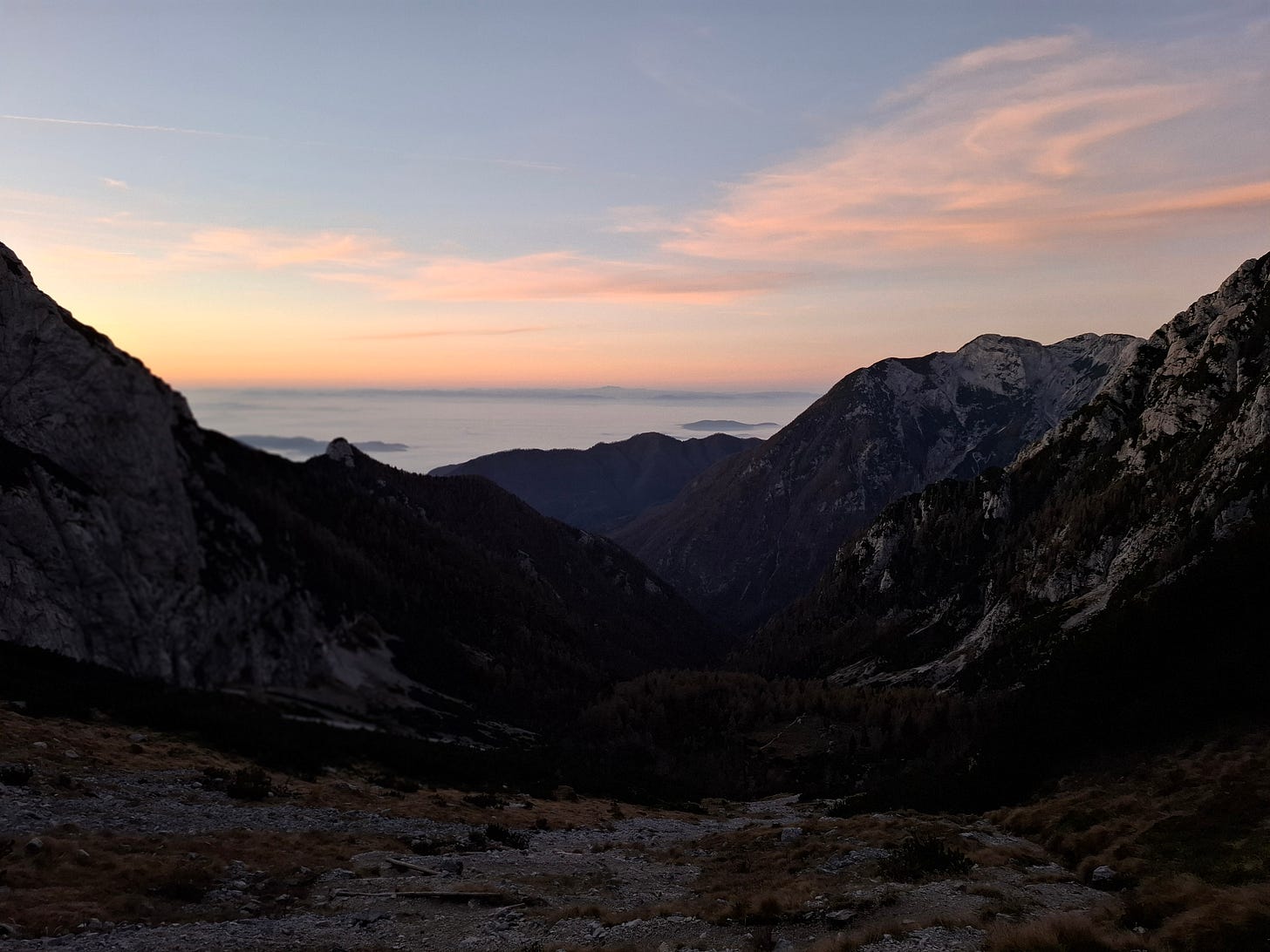Disclaimer: This market letter represents the views and opinions of the author. It does not constitute investment advice. It is my online journal to share knowledge of an alternative philosophy of financial markets and how I use this philosophy to trade. You should consult a financial adviser if you require professional assistance with your portfolio. I am not a financial adviser.
Summary
Unrevised.
The ASX 200 will likely peak between 8402 and 8700 points in mid-November. This will likely be a multi-year top.
Following this peak, a 2–3-year bear market will take place. From peak to trough, the decline will likely be around 24%.
Sometime in 2027 or 2028, a new secular bull market will commence, defined here as a significant multi-decade advance. Wave Structure suggests it will be the greatest bull market in the history of Australian equities.
In the wake
Exhibit 1 illustrates the price movement for the ASX 200 this past week.
Five weeks ago, I wrote:
8402 is the minimum target, and there is a good chance it will overshoot by a reasonable margin… The downside risk is likely contained to circa 8050-8100 points.
For the past five weeks, the ASX 200 has held the line in the sand at 8050-8100 points, reinforcing the likelihood that the current interpretation of price behaviour is accurate.
Forecast
Exhibit 2 depicts the prevailing interpretation of price behaviour on the weekly high-low chart for the ASX 200.1
The forecast above has undergone a slight revision from the previous week.
The best explanation of price behaviour from late 2023 is a NEoWave Contracting Triangle, a corrective price pattern consisting of five segments or waves labelled alphabetically (A-B-C-D-E). Appendix One provides a deep dive into this price pattern.
23WC is expected to peak between 8402 and 8700 points in mid-November.2
In a Contracting Triangle, the ideal price conclusion of wave-C is 61.8% of wave-A, which gives a price target of 8402 points. However, in cases where wave-C reaches the highest point of the price pattern, it is likely to exceed the ideal price conclusion by a margin.3 As a result, 23WC will probably peak between 8402 and 8700 points. While I believe 23WC will peak around 8600 points, it is essential to remain vigilant from 8402 points onwards.
Regarding time, the duration of 23WC should be the average of 23WA and 23WB. This suggests late October or early November as the ideal peak or conclusion. If 23WC extends past the ideal price target of 8402 points, which I believe it will, then it is likely to terminate slightly later as well.4 5 Mid-November is the best candidate for a top per the forecast from the daily high-low chart below.
Looking forward, 23WD will likely bottom somewhere around 7700 points in 1Q2025 (first quarter of 2025). So, the ASX 200 may finish the year around 8200 points, which is the end-of-year target I provided at the start of this year. See here.
Exhibit 3 depicts the prevailing interpretation of price behaviour on the daily high-low chart for the ASX 200.
The forecast above has undergone a slight revision from the previous week.
The best explanation of price behaviour from early August is a NEoWave Diametric, a corrective price pattern consisting of seven segments or waves labelled alphabetically (A-B-C-D-E-F-G).
Diametrics display several distinct characteristics. Firstly, five out of the seven waves tend towards time equality. They exhibit a pattern of contraction followed by expansion, or the reverse, often resembling a bowtie or diamond shape. They also lack Fibonacci relationships in price, with most adjacent waves retracing significantly more than 61.8% of the preceding wave.
Waves A and G usually relate by 100% in both price and time. The second most common relationship is 61.8%. The aforementioned forecast presumes that (G) will mirror (A) by 100% in terms of price and duration.
Measuring time from the actual low of (F), as is commonly done, points to Thursday November 21 as the ideal conclusion date for (G).
Calculating a specific price target is more complicated. (G) could have commenced from the low of 8063.2 points or possibly from a higher low of 8150.1 points (yesterday). These two points generate targets of 8551 and 8643 points.
Smart money
Exhibit 4 compares the ASX 200 with the Last Hour Index, the cumulative measure of the net change in a share market index during the last hour of trade.
The premise behind this indicator is that professionals are most active during the final hour of trading, a time when liquidity reaches its zenith. This interval also marks the final chance to initiate or liquidate positions within regular trading hours. Therefore, the Last Hour Index offers an alternative view of risk appetite with turning points in this indicator typically preceding turning points in the benchmark index.
The Last Hour Index continues to power higher. It presages the likelihood of higher prices for the ASX 200 in the not-too-distant future.
If a significant top is pending, I would expect this indicator to turn down very shortly.
Market Internals
Exhibit 5 compares the ASX 200 with the Composite Advance-Decline Line (A-D Line).
The A-D Line is a representation of the cumulative total of the number of advancing issues (stocks that closed higher) minus the number of declining issues (stocks that closed lower) each day. When most stocks are moving higher, the A-D Line rises. Conversely, a declining A-D Line indicates that most stocks are moving lower. It provides a strong indication of the health of a market trend. The greater the participation of stocks, the greater the chance the trend will continue in the foreseeable future.
The chart above does not include data for Friday.
While the ASX 200 is trading higher since November 1, the Composite Advance-Decline Line is lower. The expectation is that this divergence will increase if we are approaching a significant peak within the next few weeks.
Risk Management
Until November 21 or thereabouts, downside risk from current levels is minimal to non-existent. The minimum upside target over the same timeframe is 8402 points, with a reasonable chance that it overshoots to 8600. The risk-reward profile is skewered to the upside at current levels.
Investment accounts
With the likelihood of a pending multiyear peak for Australian shares, I will be selling non-core holdings into any future strength and initiating hedges to insure against downside risk with remaining stocks.
The more the ASX 200 climbs above 8402, and the nearer we approach November 21, the stronger my inclination to sell becomes.
Trading Accounts
I will be looking to take profits on levered longs and initiate levered shorts.
Disclosure: I am long and strong the ASX 200 levered.
The view from Kamnik Saddle, Slovenia.
Appendix One
The NEoWave Contracting Triangle is a corrective price pattern consisting of five segments or waves: three trending waves labelled A, C, and E, and two countertrend waves, B and D.
Each successive trending wave is smaller than the preceding one, hence the designation "contracting".
PRICE
Wave-A is a significant violent move. It is usually the longest leg of the triangle.
Wave-B should retrace at least 33-38.2% of wave-A. It usually retraces around 80%. In some instances, wave-B can be the longest wave of the triangle.
The ideal price conclusion of wave-C is 61.8% of wave-A. In some instances, when this wave reaches the highest point of the price pattern, it will extend past the ideal price conclusion by a margin.
Wave-D should retrace at least 33-38.2% of Wave-C. It usually retraces 61.8% or more. It should alternate with wave-B in as many ways as possible. Alternation can occur via the following: price, time, retracement, complexity (essentially how many up and down moves comprise the wave) and construction (each leg of a triangle will subdivide into its own price pattern if the chart shows sufficient detail). Wave-D can be longer than Wave B - this is known as reverse alternation (this is not permissible in orthodox Elliott Wave).
TIME
Although Wave-B is usually longer than Wave-A in duration, there are instances where it can be shorter.
When two adjacent waves of a triangle are similar in time, the next wave will likely be the sum of the combined times of the two adjacent waves. If the two adjacent waves are very different in duration, the duration of the next wave will likely be the average of the two adjacent waves.
POST PATTERN BEHAVIOUR
The thrust after a NEoWave Contracting Triangle will generally be as large as the widest wave of the Triangle. Confirmation of a new trend requires the initial rally to be larger and faster than the longest countertrend rally of the price pattern, either wave-B or -D.
Lexicon
Corrective price pattern: A reaction against the prevailing trend of one larger degree. Overlapping is a common feature although it is not a strict prerequisite. Corrections are an outgrowth of indecision or ambiguity with respect to the future. They are labelled alphabetically (A-B-C etc).
Elliott Wave Principle: the idea that market behaviour is self-affine in nature due to recurrent oscillations in public opinion across different but simultaneous timeframes. It posits that price action can be defined, quantified and classified, and used to project the future evolution of price.
Impulsive price pattern: A fast-moving market. Impulse waves produce a significant change in the price level. A distinctive feature is minimal or no overlapping, depicting a strong level of conviction about the outlook. They contain five segments labelled numerically (waves 1-2-3-4-5).
NEoWave: Neely Extensions of Elliott Wave. The body of knowledge enunciated by Glenn Neely, represents a significant break or extension of the original theory postulated by Ralph Elliott.
Price behaviour: the quantitative assessment of price action. Essentially, the largest, fastest moves are always in the direction of the prevailing psychological trend.
Wave structure: the quantitative relationship between different waves of price action.
Transmission time:
Sydney: 08-November-2024 16:13
Ljubljana: 08-November-2024 06:13
London: 08-November-2024 05:13
New York: 08-November-2024 01:13
A high-low chart plots the period's highs and lows in the order in which they occur. I only utilise price action between 10:10 and 16:00 when the market is fully open.
23WC is the nomenclature for Wave-C of the price pattern that commenced in 2023. This means of labelling was developed by the late Zoran Gayer.
This is known as Supplemental Price Action.
In NEoWave, time is measured using the lows and highs rather than the actual beginning or ending of the pattern. This means that nearby lows and highs, even if they do not belong to the price pattern, are usually used. If the wave to be forecast commences well after the low or high, applying time from the beginning will likely yield a better forecast.
This is known as Supplemental Time Action.











